What is Aluminum Ceiling Grid?
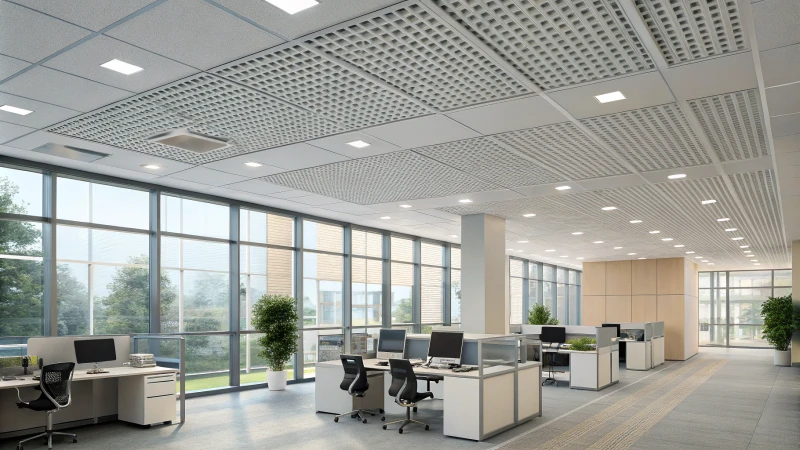
Are you considering aluminum ceiling grids for your next project?
An aluminum ceiling grid is a lightweight, durable framework system used to support ceiling tiles, ideal for both commercial and residential applications. It offers superior corrosion resistance, easy installation, and can be customized for aesthetic needs, making it a preferred choice in various industries.
Understanding the intricacies of aluminum ceiling grids can significantly impact your project outcomes. Dive deeper into their unique features and advantages as we explore various aspects of this essential component in modern construction.
What are the main components of an aluminum ceiling grid?
Exploring the components of an aluminum ceiling grid reveals its effective design and functionality in suspended ceilings.
An aluminum ceiling grid consists of main runners, cross tees, corner connectors, and ceiling tiles, providing structural support and aesthetic appeal while allowing easy access to utilities.
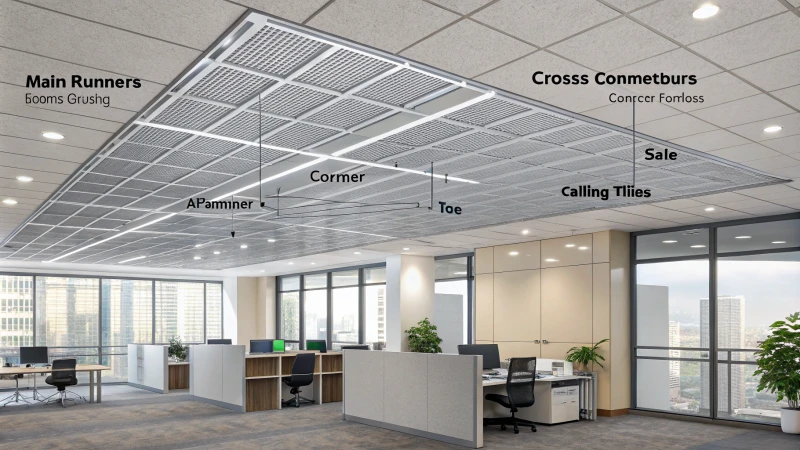
Main Runners: The Backbone of the Grid
The main runners are the primary horizontal beams that form the backbone of an aluminum ceiling grid.
Typically spaced 4 feet apart, these runners provide structural support and are essential for ensuring the stability of the entire system.
They can handle significant weight loads, accommodating various types of ceiling tiles or panels.
Their corrosion-resistant properties make them ideal for both commercial and residential installations, especially in humid environments.
For example, in high-humidity areas like kitchens, aluminum main runners will not rust, unlike their steel counterparts.
Cross Tees: Connecting the Structure
Cross tees are secondary beams that connect between the main runners, creating a grid-like pattern.
These components are crucial for securing the ceiling tiles in place and are typically available in various lengths to accommodate different ceiling designs.
When installed properly, cross tees facilitate easy access to utilities above the ceiling, making maintenance more manageable.
They also contribute to the overall aesthetic of the ceiling by providing a neat and organized appearance.
It’s worth noting that cross tees can often be adjusted to allow for varying tile sizes, enhancing flexibility in design.
Corner Connectors: Completing the Grid
The corner connectors are essential for joining the ends of main runners and cross tees together, ensuring a solid framework.
These connectors can come in various shapes, such as L-shaped or T-shaped, depending on the configuration required.
Their role is critical in maintaining the integrity and stability of the grid system, allowing it to support the weight of ceiling tiles effectively.
Additionally, they often feature snap-fit designs for quick assembly, reducing installation time significantly.
Ceiling Tiles: The Finishing Touches
The final component of an aluminum ceiling grid system is the ceiling tiles themselves.
These tiles come in a variety of materials, including acoustic panels, metal tiles, and mineral fiber options.
The choice of tile can affect not only the aesthetics but also the acoustics and lighting efficiency of a space.
For example, acoustic tiles can help reduce noise levels in busy environments like offices or auditoriums, making them a popular choice for such settings.
A table below summarizes different types of ceiling tiles and their specific benefits:
| Type of Ceiling Tile | Material | Benefits |
|---|---|---|
| Acoustic Panels | Fiberglass | Noise reduction, improved sound quality |
| Metal Tiles | Aluminum | Durability, modern aesthetic |
| Mineral Fiber Tiles | Fiberboard | Cost-effective, moisture resistance |
| PVC Tiles | Plastic | Lightweight, easy to clean |
Installation Considerations
When planning an installation, understanding how these components work together is vital for achieving a successful outcome.
Proper alignment and spacing between main runners and cross tees can significantly impact the final appearance and functionality of the ceiling grid.
Furthermore, it’s essential to consider factors such as load-bearing capacity and local building codes when selecting materials and designing the layout.
For more detailed insights on installation best practices, check out our resources on installation techniques.
How does an aluminum ceiling grid compare to other materials?
Discover how aluminum ceiling grids stack up against other materials like drywall and PVC in terms of durability, maintenance, aesthetics, and cost-effectiveness.
Aluminum ceiling grids offer superior durability and corrosion resistance compared to drywall and PVC. They are easy to install and maintain, customizable for aesthetics, making them a preferred choice in many commercial applications.
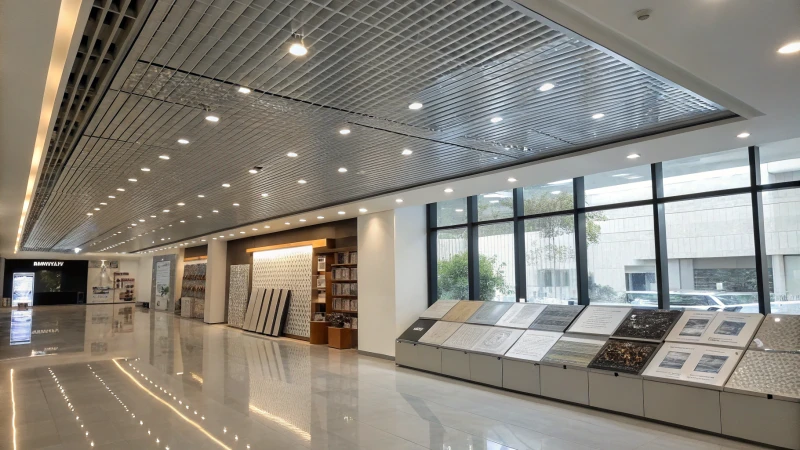
Comparing Durability
Aluminum ceiling grids excel in durability when compared to materials like drywall and PVC.
They are resistant to corrosion, especially in humid environments where steel might fail.
| Material | Durability | Corrosion Resistance | Ideal Environments |
|---|---|---|---|
| Aluminum | High | Excellent | Humid areas (pools, kitchens) |
| Drywall | Moderate | Poor | Indoor, low-humidity |
| PVC | Low | Moderate | Indoor, dry environments |
This means that for projects in areas prone to moisture, aluminum is often the go-to choice.
Maintenance and Installation
Another significant factor is maintenance and installation ease. Aluminum grids are lightweight and modular, allowing for rapid installation. This can greatly reduce labor costs and time, unlike heavier materials.
- Aluminum: Quick installation and easy tile replacement.
- Drywall: Requires more labor-intensive installation, with potential for damage during maintenance.
- PVC: While lightweight, it may not be as durable in high-traffic areas.
For businesses managing large spaces, the efficiency of aluminum grids can result in substantial savings over time, as seen in installation case studies.
Aesthetic Appeal
Aesthetics play a critical role in selecting ceiling materials. Aluminum grids can be customized through various finishes like powder coating or anodizing, making them suitable for diverse design preferences.
| Material | Customization Options | Common Applications |
|---|---|---|
| Aluminum | High (color, finish) | Commercial spaces, hotels |
| Drywall | Limited (paint only) | Residential |
| PVC | Moderate (color only) | Basic commercial settings |
This capability allows businesses to maintain a cohesive brand identity while enhancing the visual appeal of their spaces. For more on aesthetic options, see design inspiration.
Cost Analysis
When considering costs, aluminum may appear pricier upfront compared to PVC or drywall, but its longevity and reduced maintenance needs often lead to lower overall expenses in the long run.
- Aluminum: Higher initial investment; lower lifetime costs.
- Drywall: Moderate cost; regular maintenance required.
- PVC: Low cost; may need replacement sooner.
Understanding these cost dynamics can be crucial for procurement managers looking to optimize budgets. Learn more about cost-saving strategies.
What are the advantages of using aluminum ceiling grids in commercial spaces?
Discover the multiple benefits of using aluminum ceiling grids in commercial spaces that can enhance functionality and aesthetics.
Aluminum ceiling grids provide numerous advantages for commercial spaces, including durability, ease of installation, acoustic benefits, customization options, and long-term cost effectiveness.
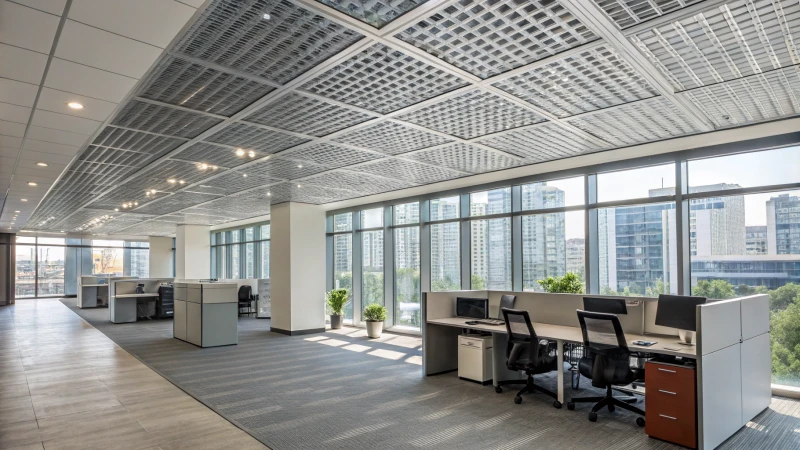
Superior Durability and Corrosion Resistance
Aluminum ceiling grids are celebrated for their remarkable durability, especially in commercial settings. Unlike steel, aluminum does not rust, making it an ideal choice for environments prone to moisture.
For example, in spaces like kitchens or swimming pools, aluminum grids maintain their integrity over time, which is crucial for long-term maintenance. Additionally, this durability translates to lower replacement costs over the years.
| Feature | Aluminum Grids | Steel Grids |
|---|---|---|
| Corrosion Resistance | High | Moderate |
| Weight | Lightweight | Heavier |
| Maintenance Frequency | Low | High |
Ease of Installation and Maintenance
One of the standout advantages of aluminum ceiling grids is their lightweight nature, which simplifies the installation process. This can significantly reduce labor costs, a critical factor for commercial projects.
The modular design allows for quick tile replacements, ensuring minimal disruption to business operations. This ease of maintenance is essential for facilities that require frequent updates or repairs.
- Time Savings: Faster installation processes mean quicker project completion.
- Cost Efficiency: Reduced labor costs due to simpler installation techniques.
Acoustic Benefits
In commercial spaces where sound management is crucial, aluminum ceiling grids can be paired with acoustic panels to enhance noise reduction. This is particularly beneficial in environments such as:
- Offices: Where concentration is key.
- Auditoriums: For clearer sound delivery during presentations.
By integrating these systems, businesses can create a more pleasant auditory environment, which is essential for employee productivity and client satisfaction.
Customization Options
Aluminum ceiling grids offer extensive customization options to align with various aesthetic preferences and brand identities. Businesses can choose from a range of finishes including:
- Powder coating
- Anodizing
- Brushed metal finishes
This flexibility is particularly valuable in commercial spaces where the visual appeal is essential. By selecting the right finishes, companies can enhance their interiors while maintaining a professional look.
Long-Term Cost Effectiveness
While the initial investment in aluminum ceiling grids may be higher than alternatives like PVC or steel, the lifetime cost often proves lower. Factors contributing to this include:
- Lower Maintenance Needs: Less frequent repairs or replacements.
- Durability: Longer lifespan means fewer installations over time.
For procurement managers, understanding the total cost of ownership versus the initial purchase price is vital when making purchasing decisions. Exploring insights on cost effectiveness of materials can further aid in this evaluation.
How can aluminum ceiling grids enhance interior design?
Discover how aluminum ceiling grids can elevate your interior design game with their unique blend of style and practicality.
Aluminum ceiling grids enhance interior design by offering aesthetic appeal through customizable finishes, functional benefits like durability and acoustic control, and energy efficiency by supporting advanced lighting solutions.
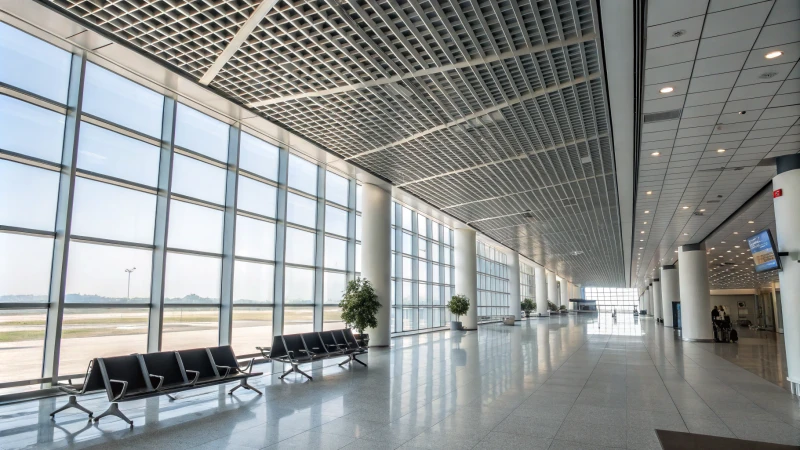
Aesthetic Appeal of Aluminum Ceiling Grids
Aluminum ceiling grids offer a modern and sleek appearance that can significantly enhance the aesthetic quality of a room. Their lightweight design allows for creative configurations, enabling architects and designers to play with geometric patterns and spacing.
These grids can be finished in various styles, including powder coating and anodizing, to match any interior decor. For example, a brushed aluminum finish can add a touch of elegance to a corporate office, while vibrant colors can make a statement in a creative workspace.
Explore how different finishes can transform spaces.
Functional Benefits of Aluminum Ceiling Grids
Beyond aesthetics, aluminum ceiling grids serve functional purposes that contribute to the overall design and efficiency of spaces. Here are key advantages:
| Benefit | Description | Example Scenario |
|---|---|---|
| Durability | Aluminum is resistant to corrosion, making it suitable for humid environments like kitchens. | Ideal for restaurant ceilings. |
| Acoustic Control | Pairing grids with acoustic panels helps in noise reduction, essential for offices and theaters. | Useful in conference rooms. |
| Accessibility | Easy access to utilities above the ceiling allows for straightforward maintenance and upgrades. | Important for facilities management. |
These functional features demonstrate how aluminum ceiling grids can enhance both the look and functionality of any interior design project.
Customization for Unique Designs
Aluminum ceiling grids can be tailored to meet specific design requirements, allowing for a truly customized interior. Designers can specify dimensions, colors, and finishes, making it easier to align with brand identity or personal taste.
Custom grids can also incorporate integrated lighting solutions, further enhancing both aesthetics and functionality. Businesses can achieve unique looks while ensuring that their design reflects their vision. Learn more about custom ceiling options.
Energy Efficiency Considerations
Incorporating aluminum ceiling grids into the design can lead to improved energy efficiency as they support modern lighting systems that use LED technology. These lighting systems not only provide better illumination but also reduce energy consumption.
Additionally, the reflective properties of aluminum can enhance natural light distribution within a space, contributing to a brighter environment without increasing energy costs. This aspect is crucial for businesses focused on sustainability and reducing their carbon footprint. Find out more about energy-efficient designs.
What should you consider when selecting an aluminum ceiling grid for your project?
Selecting the right aluminum ceiling grid involves multiple factors that ensure functionality and aesthetic appeal. Here’s what you should consider before making your choice.
When selecting an aluminum ceiling grid for your project, consider durability, installation ease, acoustic properties, customization options, and long-term costs. These factors will help you achieve both practical and aesthetic goals.
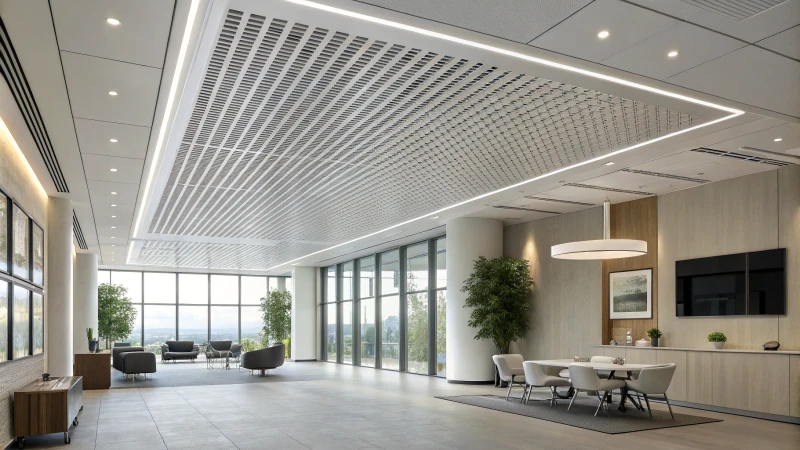
Understanding the Purpose of the Grid
Before selecting an aluminum ceiling grid, it is crucial to understand its intended purpose in your project. Whether for acoustic control, aesthetic appeal, or functional support, the right grid system will significantly impact the overall environment. For instance, acoustic ceiling tiles can be paired with the grid to enhance sound quality in spaces like auditoriums.
Durability and Environment Considerations
Durability is a top priority, especially in environments that may experience moisture or corrosive elements. Aluminum grids are superior in these areas compared to other materials. Consider the environment:
| Environment Type | Recommended Material |
|---|---|
| Humid (e.g., kitchens) | Aluminum |
| Dry (e.g., offices) | Aluminum or Steel |
| Corrosive (e.g., pools) | Aluminum |
This table illustrates how aluminum performs against other materials in various settings, making it essential for your project’s longevity.
Installation and Maintenance Efforts
The ease of installation is another critical factor. Aluminum grids are lighter, which reduces labor costs and installation time. Here’s a quick overview of installation advantages:
- Lightweight: Less physical strain on installers.
- Modular Design: Allows for quick adjustments and tile replacements.
- Low Maintenance: Requires minimal upkeep compared to heavier materials.
For more tips on effective installation methods, check this installation guide.
Acoustic Properties and Sound Management
For projects focused on noise reduction, consider pairing your aluminum grid with specialized acoustic panels. The combination can significantly dampen sound, creating a more comfortable environment:
- Acoustic Ceiling Panels: Improve sound quality in busy spaces.
- Noise Reduction Coefficients (NRC): Aim for higher NRC ratings for better performance.
A well-designed grid system can drastically improve sound management in areas such as offices or conference rooms. Learn more about acoustics in design here.
Aesthetic Customization Options
Customization is key when selecting an aluminum ceiling grid to fit your project’s design vision. Aluminum grids offer a variety of finishes:
| Finish Type | Description |
|---|---|
| Powder Coated | Durable and available in many colors |
| Anodized | Offers a sleek metal finish and corrosion resistance |
| Brushed Metal | A modern look that adds sophistication |
Exploring these options can help align your project with specific design themes or branding requirements. Consider checking out customization options to find the perfect match.
Cost Considerations and Long-Term Value
While aluminum grids might have a higher initial cost, their long-term benefits often outweigh this expense. It’s essential to analyze the lifetime costs:
- Upfront Costs: What you pay initially.
- Maintenance Costs: Lower for aluminum compared to alternatives.
- Longevity: Aluminum’s durability often leads to fewer replacements over time.
Understanding these factors can assist procurement managers in making informed decisions that benefit their projects financially in the long run.
Conclusion
Aluminum ceiling grids provide a durable, customizable framework for ceiling tiles, offering corrosion resistance and ease of installation, making them ideal for various commercial and residential applications.



